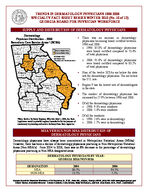TRENDS IN DERMATOLOGY PHYSICIANS 1996-2006 SPECIALTY FACT SHEET SERIES WINTER 2010 (No. 10 of 12)
GEORGIA BOARD FOR PHYSICIAN WORKFORCE
SUPPLY AND DISTRIBUTION OF DERMATOLOGY PHYSICIANS
Dermatology Physician Distribution 2006
Secondary Care Service Areas* (SCSA)
Dade Catoosa
Murray
Fannin
Towns Rabun
Union
Whitfield Walker
Gilmer
White Habersham
Chattooga Gordon
Region 1
1.1
Floyd
Bartow
Lumpkin
Region
2
Stephens
Pickens Dawson
2.2 Banks Franklin Hart
Cherokee Forsyth Hall
Jackson Madison Elbert
Below State Rate Above State Rate
GA Rate = 3.0 US Rate = 3.6
Polk Paulding
Haralson
Cobb
Gwinnett
Region 3
Dekalb
4.1
Barrow Clarke Oglethorpe
Walton Oconee
Region 5
Wilkes
* Physicians per 100,000 population
Lincoln
Carroll
Douglas
Rockdale
Fulton Clayton
Newton
2.5 Morgan Greene Taliaferro
Columbia
McDuffie
Region 7 Coweta
Heard
Henry Fayette
Butts Spalding
Jasper
Warren Putnam
Hancock Glascock
Richmond
Reg1io.5n 4 Region 6 5.6 Troup Meriwether Pike Lamar Monroe
Baldwin Jones
Jefferson Washington
Burke
Harris
Upson
Talbot
2.4 Bibb
Crawford
Wilkinson
Twiggs
Johnson Emanuel
Jenkins
Screven
Taylor
Peach
Muscogee
Bulloch
Region 8 Marion
Bleckley Laurens Houston
Treutlen
Candler
Region 9 Region 12 Chattahoochee
Macon
2.8 Schley
Pulaski Dodge
Montgomery
Evans
0.7 3.0 Stewart Webster
Sumter
Dooly
Wilcox
Wheeler
Tatnall Toombs
Effingham Bryan Chatham
Crisp
Telfair
Liberty
Quitman
Terrell Lee
Turner
Ben Hill
Jeff Davis Appling
Long
Randolph
Irwin
Coffee Bacon
Wayne
McIntosh
Clay Calhoun Dougherty Worth
Tift
Region 11
Region 10
Early
Baker
Berrien 0.8
Pierce
Glynn
0.8 Miller
Mitchell Colquitt
Cook
Atkinson
Ware
Brantley
Seminole Decatur
Grady Thomas Brooks
Lanier Lowndes
Clinch
Charlton
Camden
Echols
There was an increase in dermatology physicians becoming board certified between 1996 and 2006. o 1996: 85.0% of dermatology physicians
were board certified compared to 73.4% of total physicians.
o 2006: 91.8% of dermatology physicians were board certified compared to 83.2% of total physicians.
Nine of the twelve SCSAs are below the state rate for dermatology physicians. Ten are below the U.S. rate.
Region 9 has the lowest rate of dermatologists in the state.
The number of dermatology physicians has increased by 27.9% between 1996 and 2006.
Of all the dermatology physicians: o 1996: 9.3% were residents o 2006: 2.4% were residents
*State Service Delivery Regions; Effective July 1, 1998, the State Legislature voted to provide regional boundaries for the purpose of consistency in planning and service delivery from State Agencies.
Of all the residents:
o 1996: 2.6% were in dermatology o 2006: 1.7% were in dermatology
MSA VERSUS NON-MSA DISTRIBUTION OF DERMATOLOGY PHYSICIANS
Dermatology physicians have always been concentrated in Metropolitan Statistical Areas (MSAs). However, there has been a decline of dermatology physicians practicing in Non-Metropolitan Statistical Areas (Non-MSA's). From 2004 to 2006, there was an 8% decrease in the percentage of dermatology physicians practicing in Non-MSA designated areas.
DERMATOLOGY PHYSICIANS BY YEAR: GEORGIA MSA/NON-MSA
DESIGNATION MSA
NON-MSA
2004 86.5% 13.5%
2006 94.5% 5.5%
Georgia Board for Physician Workforce 1718 Peachtree St., N.W., Suite 683, Atlanta, Georgia 30309, (404) 206-5420 www.gbpw.georgia.gov Cherri Tucker, Executive Director. Colette Caldwell, Carla Graves, Kelly McNamara, and G.E. Alan Dever, M.D., Ph.D., contributors.
DEMOGRAPHICS
Dermatology Physicians By Gender
100
75.1%
80
65.8%
60
34.2%
40
24.9%
20
0 Male
Female
1996 2006
Dermatology Physicians By Race
100 94.1%
74.9% 80
60
40
20
0 White
16.0%
4.3%
1.6% 6.1%
0% 3.0%
Black
Asian
1996 2006
Other
Since 1996, there has been a 9.3% increase in the number of female dermatology physicians practicing in Georgia. Additionally, the percentage of black physicians has increased by 11.7%, while the percentage of white dermatology physicians has decreased by 19.2% since 1996.
Percentage of Dermatology Physicians and Total Physicians Age 55 and Older
1996 and 2006
40
30
25.2% 23.5%
32.2% 26.3%
The percentage of dermatology
physicians age 55 and older increased by 7% between 1996 and 2006.
20
10
0 1996
2006
Dermatology Total Physicians
Similarly, the percentage of total
practicing physicians age 55 and older increased by 2.8% during the same time.
TRENDS IN THE NUMBER AND RATE OF DERMATOLOGY PHYSICIANS
Overall, the NUMBER of dermatology physicians practicing in Georgia has increased from 1996 to 2006. However, when the numbers are compared to changes in the population for the same period, Georgia has actually remained somewhat constant in the RATE of dermatology physicians. In 1996, Georgia had a rate of 2.9 dermatology physicians compared to 3.0 in 2006.
Total Number
300
275 275
250 215 225 244 247
200
Rate per 100,000 Population 4
2.9 3
2.9
2.9
2.8
3.1
3.0
150
2
100
1 50
0 1996 1998 2000 2002 2004 2006
0 1996 1998 2000 2002 2004 2006
